Can You Fumble into the End Zone for a Touchdown? Understanding the NFL Rulebook
Picture this: the ball is fumbled, teetering near the end zone. What happens next could be a game-changer. For a fumble to morph into a touchdown, a crucial rule comes into play: only the player who fumbled can recover the ball in the opposing team’s end zone to score a touchdown for their team. If another offensive player scoops it up? Well, it’s not a touchdown, but they still keep the ball at the fumble spot.

Related Post! Fumble In Football: Understanding Causes And Prevention Strategies
Can You Fumble into the End Zone for a Touchdown?
Absolutely, you can fumble into the end zone for a touchdown in football. However, this only results in a touchdown if the fumbling player or a teammate legally recovers the ball in the end zone. The rules differ if it’s fourth down or in the final two minutes of each half.
This rule isn’t just a random quirk; it’s a strategic safeguard. Without it, teams might ‘accidentally-on-purpose’ fumble forward into the end zone, turning a risky move into a scoring tactic.
What Happens in Different Scenarios? The plot thickens depending on who recovers the fumble:
- Offensive Recovery: If the fumbling player’s team recovers in the end zone, it’s a touchdown, and the crowd goes wild!
- Defensive Recovery or Out-of-Bounds: If the defense jumps on the ball in their end zone, or if the ball rolls out of bounds there, the result is a touchback. The defending team starts anew at their 20-yard line.
Key Takeaways for Fans and Players Alike:
- Touchdown Potential: A fumble can lead to a touchdown, but only if the fumbling player makes the recovery in the opponent’s end zone.
- No Touchdown on Teammate Recovery: If another offensive player recovers the fumble in the end zone, it’s a no-go for a touchdown.
- Defense and Out-of-Bounds: A defensive recovery or an out-of-bounds fumble in the end zone means a touchback.
The Rulebook’s Perspective
Delving into the official rulebook, specifically Section 7, Article 3, you’ll find the intricate details governing these high-stakes scenarios. Understanding these rules is key, whether you’re strategizing as a player or just aiming to be the most informed fan in the room.
Related Post! Advancing The Fumble: The Rules Of High School Football
Possession Nuances
In the world of fumbles and touchdowns, possession is king. Here’s a quick breakdown:
- Offensive Recovery = Touchdown: Recover your own fumble in the opponent’s end zone, and you’ve got six points.
- Defensive Recovery = Touchback: If the defense claims the fumble in their end zone, they take control at their 20-yard line.
Scoring Beyond Fumbles
While fumbles can lead to touchdowns or touchbacks, remember, they’re just one piece of the scoring puzzle in American football. Each play, each strategy, each rule interlocks to create the dynamic, unpredictable game we love.
The Act of Fumbling
Ever held a football? Then you know each grip is a delicate balance between control and the risk of a fumble, a moment that can flip the game on its head. Let’s unpack the causes, consequences, and intricate rules of fumbling, and how it can be a game-changer.
Causes and Consequences of Fumbling
A fumble is more than just losing the ball; it’s a potential game-changer. What causes it? A few key factors:
- Hard Hits: A solid tackle can jar the ball loose.
- Slips and Trips: Even the most agile players can stumble.
- Loose Handling: Secure ball control is a must.
The aftermath? If the fumbling team doesn’t recover, their opponents might snatch up the ball, swinging the momentum in their favor.
Recovery and Turnover
Here’s where agility and awareness come into play. The team that recovers the fumble gains possession, potentially altering the game’s trajectory. The rules are clear:
- Defensive Recovery: If the defense grabs the ball, they switch to offense.
- Out-of-Bounds Fumbles: The ball goes back to the last team in possession, but end zone fumbles have their own set of outcomes, like a safety or touchdown.
- Fourth Down and Final Minutes: Only the fumbling player can recover the ball in these high-pressure moments.
Officials and Penalties
In American football, it’s not just about the players; officials play a crucial role in maintaining the game’s integrity.

Role of the Referee
The referee is the boss on the field, making the final calls and ensuring the rules are upheld. They’re the ones who’ll confirm your touchdown after a fumble, as long as no rules were broken.
Flagging Penalties
Penalties are the game’s way of saying “you can’t do that.” For instance:
- Illegal Forward Pass: Fumbling forward after you’re down? That’s a penalty.
- Illegal Batting: Intentionally batting the ball towards the end zone? Expect a flag for illegal batting.
Penalties can negate touchdowns or push the offense back, depending on the situation.
In-Game Scenarios
Now, let’s dive into some specific scenarios involving fumbles and field goals.
End Zone Fumbles and Touchdowns
Fumbling into the end zone? It’s a bit of a puzzle:
- Offensive Recovery: If your team fumbles forward into the end zone and recovers, celebrate – it’s a touchdown.
- Defensive Recovery: If the defense takes control in the end zone, it’s a touchback, and they start at the 20-yard line.
- Out-of-Bounds: If the fumble rolls out of bounds in the end zone, the defense gets a touchback.
Field Goal Attempts
And when it comes to field goals:
- Successful Attempt: Kick it through the uprights and above the crossbar for three points.
- Missed Goal: Miss and it’s a touchback to the opposition.
- Blocked Kick: If blocked, the defense might run it back, or the offense can try to advance or re-kick on fourth down.
Related Post! Can The Ground Cause A Fumble In College Football?
Review and Challenges
Video Review Process
In today’s high-stakes football games, the video review is a game-changer, especially with touchdowns on the line. When a fumble happens near or in the end zone, officials often turn to video review to make the right call. They’re looking for:
- Possession Before the End Zone: Did the player hold onto the ball before crossing into the end zone?
- Down-By-Contact: Was the ball carrier down before losing the ball?
Coaches’ Challenges
Coaches are key players in this review dance. With only two challenges per game, they’ve got to use them wisely. They can challenge:
- The Occurrence of a Fumble: Was it a fumble or not?
- Who Recovered the Fumble: Who grabbed the ball first?
- Touchdown Validity: Did the fumble result in a touchdown?
Timing is crucial; challenges must be made before the next play starts. A failed challenge costs a precious timeout.
Related Post! What’s A Touchback In Football?
Game Dynamics and Strategy
Fumbling into the end zone isn’t just about the immediate play; it’s about the bigger picture of possession strategies and critical fourth-down decisions.
Possession Strategies
Keeping a tight grip on the ball is non-negotiable, especially near the end zone. To reduce turnover risks:
- Double-Handed Security: Always hold the ball with both hands in contact situations.
- Defensive Awareness: Keep an eye on where the defenders are.
Fourth Down Decisions
On fourth down near the end zone, teams face a pivotal choice: kick for a safer three points or go for a touchdown with a higher risk and reward. This decision hinges on the game’s score, field position, and remaining time.
Player and Team Specific Examples

- Notable NFL Players: Take Justin Jefferson of the Vikings, known for his red-zone ball control, or Kirk Cousins, whose grip near the goal line is crucial.
- Memorable NFL Games: Remember that Eagles game on Thursday Night Football? A fumble recovery for a touchdown dramatically shifted the game. Or those Raiders games, where end zone fumbles led to turnovers, showing how fine the line is between triumph and letdown.
Implications of Gameplay
A fumble into the end zone is a high-stakes moment with two key considerations:
- Impetus: The offense’s action propels the ball, affecting who gains possession in the end zone.
- Breaking the Plane: Hold onto the ball and break the end zone plane? Touchdown!
- Staying Inbounds: If the ball goes out of bounds in the end zone post-fumble, it could mean a turnover.
Consequences
If you’re the one who fumbles:
- Defensive Recovery: If the defense recovers in their end zone, it’s a touchback, and they take control.
- Offensive Recovery: If your teammate recovers in the end zone and stays inbounds, it’s a touchdown.
In the heat of the game, knowing your position relative to the end zone and maintaining control of the football is crucial. Your actions can swing the game, impacting scoring opportunities and turnover risks. Understanding these dynamics is key to navigating the intense world of football.
Frequently Asked Questions
Navigating the complexities of fumbles and touchdowns in football can be tricky. These FAQs will clarify how fumbles in the end zone are dealt with and how they differ between the NFL and college football.
What are the implications of a player fumbling the ball into the opponent’s end zone?
If you fumble the ball into the opponent’s end zone and the opponent recovers, the play typically results in a touchback for the other team. This means the opponent gets possession of the ball and starts their drive from their own 20-yard line.
How is a fumble recovered in the end zone treated under NFL regulations?
According to NFL regulations, a touchdown is awarded if you recover your teammate’s fumble in the opponent’s end zone. However, if you fumble it and then directly recover the ball in the end zone, you’re also awarded a touchdown as long as the fumble did not occur forward into the end zone.
Can a player legally claim a touchdown after recovering their own fumble in the end zone?
Yes, a player can legally claim a touchdown after recovering their own fumble in the end zone, provided the ball was not fumbled forward.
What differentiates a fumble leading to a touchback from one resulting in a touchdown?
A fumble results in a touchback when the opposing team gains possession in their own end zone. In contrast, a fumble leads to a touchdown when the fumbling player or a teammate legally recovers the ball within the opponent’s end zone.
How do college football rules differ regarding a fumble into the end zone compared to the NFL?
College football rules dictate that if you fumble the ball into the end zone and it goes out of bounds, the result is a touchback for the opposing team. You cannot regain possession by recovering the ball in the end zone after a fumble in college football, which is a notable departure from NFL rules.
What constitutes a fumble recovery in the end zone according to NFL rules?
Under NFL rules, if you establish clear possession of a loose ball in the end zone without the ball touching the ground, that constitutes a fumble recovery. If this recovery occurs in the opponent’s end zone without the presence of a foul or infraction, it’s considered a touchdown.
